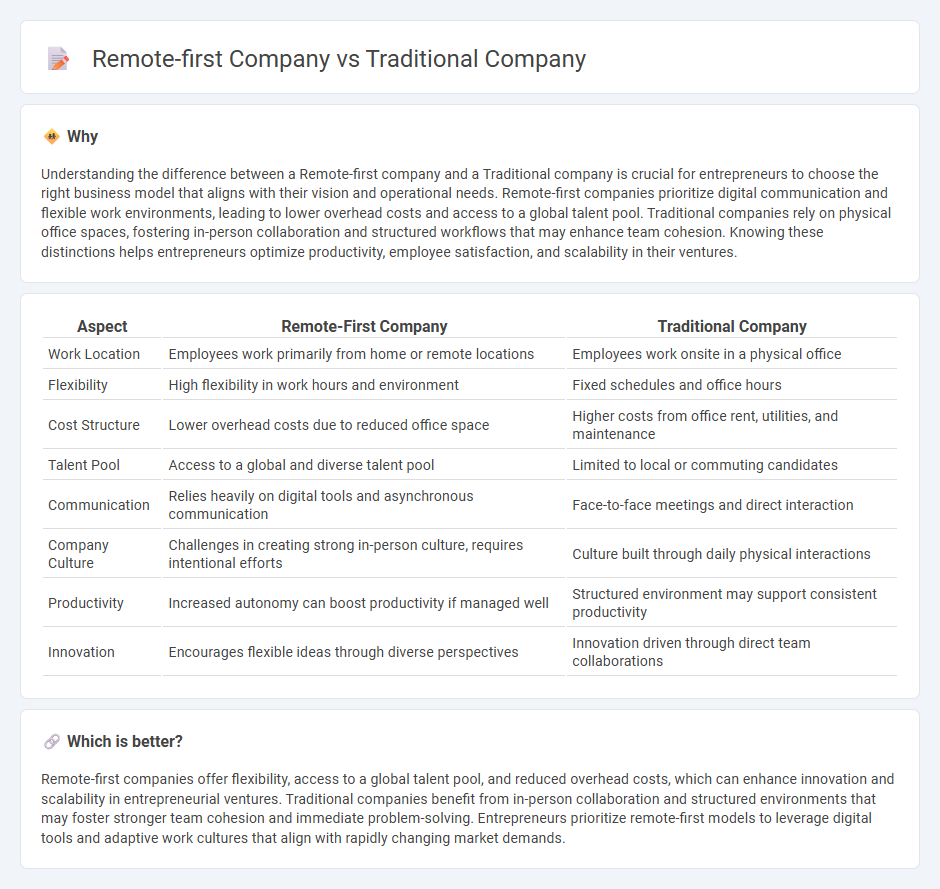
Remote-first companies prioritize flexible work environments using digital tools to enable distributed teams, enhancing productivity and access to global talent. Traditional companies maintain centralized office spaces emphasizing face-to-face collaboration and fixed schedules, often limiting scalability and agility. Explore the benefits and challenges of each model to determine the best fit for your entrepreneurial ventures.
Why it is important
Understanding the difference between a Remote-first company and a Traditional company is crucial for entrepreneurs to choose the right business model that aligns with their vision and operational needs. Remote-first companies prioritize digital communication and flexible work environments, leading to lower overhead costs and access to a global talent pool. Traditional companies rely on physical office spaces, fostering in-person collaboration and structured workflows that may enhance team cohesion. Knowing these distinctions helps entrepreneurs optimize productivity, employee satisfaction, and scalability in their ventures.
Comparison Table
| Aspect | Remote-First Company | Traditional Company |
|---|---|---|
| Work Location | Employees work primarily from home or remote locations | Employees work onsite in a physical office |
| Flexibility | High flexibility in work hours and environment | Fixed schedules and office hours |
| Cost Structure | Lower overhead costs due to reduced office space | Higher costs from office rent, utilities, and maintenance |
| Talent Pool | Access to a global and diverse talent pool | Limited to local or commuting candidates |
| Communication | Relies heavily on digital tools and asynchronous communication | Face-to-face meetings and direct interaction |
| Company Culture | Challenges in creating strong in-person culture, requires intentional efforts | Culture built through daily physical interactions |
| Productivity | Increased autonomy can boost productivity if managed well | Structured environment may support consistent productivity |
| Innovation | Encourages flexible ideas through diverse perspectives | Innovation driven through direct team collaborations |
Which is better?
Remote-first companies offer flexibility, access to a global talent pool, and reduced overhead costs, which can enhance innovation and scalability in entrepreneurial ventures. Traditional companies benefit from in-person collaboration and structured environments that may foster stronger team cohesion and immediate problem-solving. Entrepreneurs prioritize remote-first models to leverage digital tools and adaptive work cultures that align with rapidly changing market demands.
Connection
Remote-first companies and traditional companies are connected through the evolving landscape of entrepreneurship, where hybrid models blend flexible work environments with established operational structures. Both types leverage digital tools and innovative management practices to drive productivity, employee engagement, and growth. This convergence enables entrepreneurs to scale businesses by integrating remote work capabilities with traditional frameworks, fostering adaptability in dynamic markets.
Key Terms
Source and External Links
What is a traditional company? - Traditional companies generally feature individual ownership or private initiative, focusing on established knowledge, competencies, and strategic use of tradition and culture to create value and differentiate themselves from competitors.
Traditional Co. - A company founded in Los Angeles in 2005 working in the cannabis industry, emphasizing loyalty, trust, and unification rather than competition.
Traditional Medicinals - An independent company since 1974 specializing in organic herbal and medicinal teas, combining traditional plant knowledge with modern science and committed to sustainability and community impact.
 dowidth.com
dowidth.com